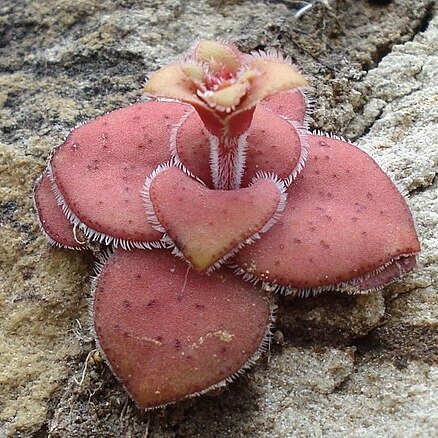Perennial or annual herb, succulent, 1 or 2 rosettes, leaf pairs spirally arranged, old ones remaining on stem, ± 0.2 m high when flowering. Leaves ovate or obovate, 15-35 x 10-25 mm, acute or obtuse, dorsiventrally flattened, glabrous with marginal cilia, green to reddish brown. Inflorescence a spike-like thyrse, sessile dichasia and flowers; peduncle short with bracts shortening upwards. Calyx fleshy, obtuse, glabrous with marginal papillae, green. Corolla tubular, fused 0.2-0.5 mm, white or cream-coloured; lobes oblong-obovate, 4.5-5.5 mm long, obtuse, erect slightly recurved. Flowering time Nov.-Mar.
Perennial or annual herb. Stems up to 0.2 m high when flowering, shortly tomentose. Leaves fleshy; in a rosette, abruptly shorter below inflorescence; blade ovate, elliptic or obovate, 15-35 x 10-25 mm, apex acute to obtuse, dorsiventrally flattened, glabrous except for a dense row of marginal cilia, green to reddish brown. Flowers: in a spike-like thyrse; with ± sessile dichasia and flowers, peduncle covered with bracts; 5-merous; anthers black; calyx lobes acute; corolla tubular, lobes oblong-obovate, 4.5-5.5 mm long, apices obtuse, erect or slightly recurved, white or cream-coloured; Nov.-Mar.
Perennial or annual herb, up to 200 mm tall, with 1 or 2 rosettes. Stems shortly tomentose. Leaves with dense row of marginal cilia (touching one another). Inflorescence a spike-like thyrse. Flowers white or cream.

